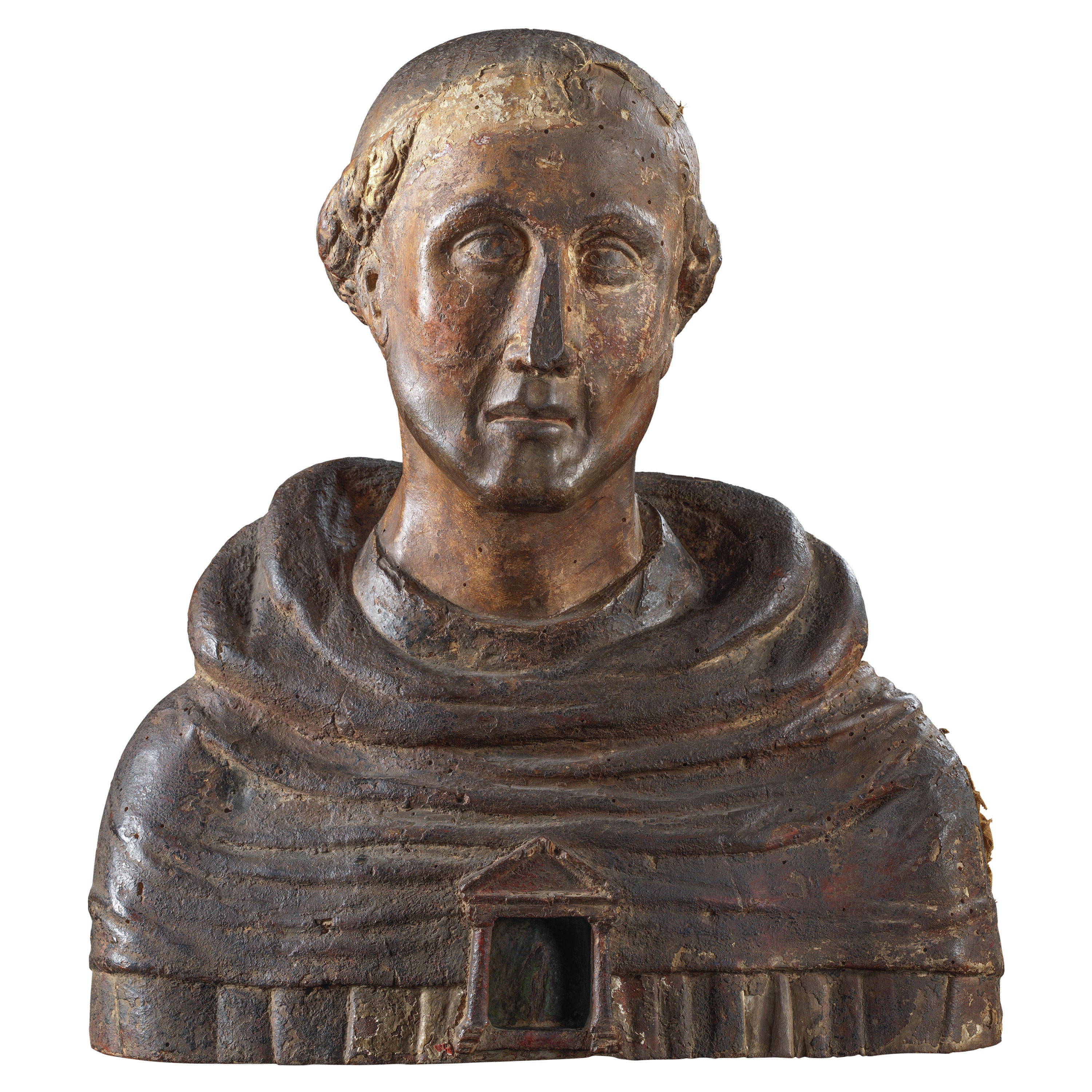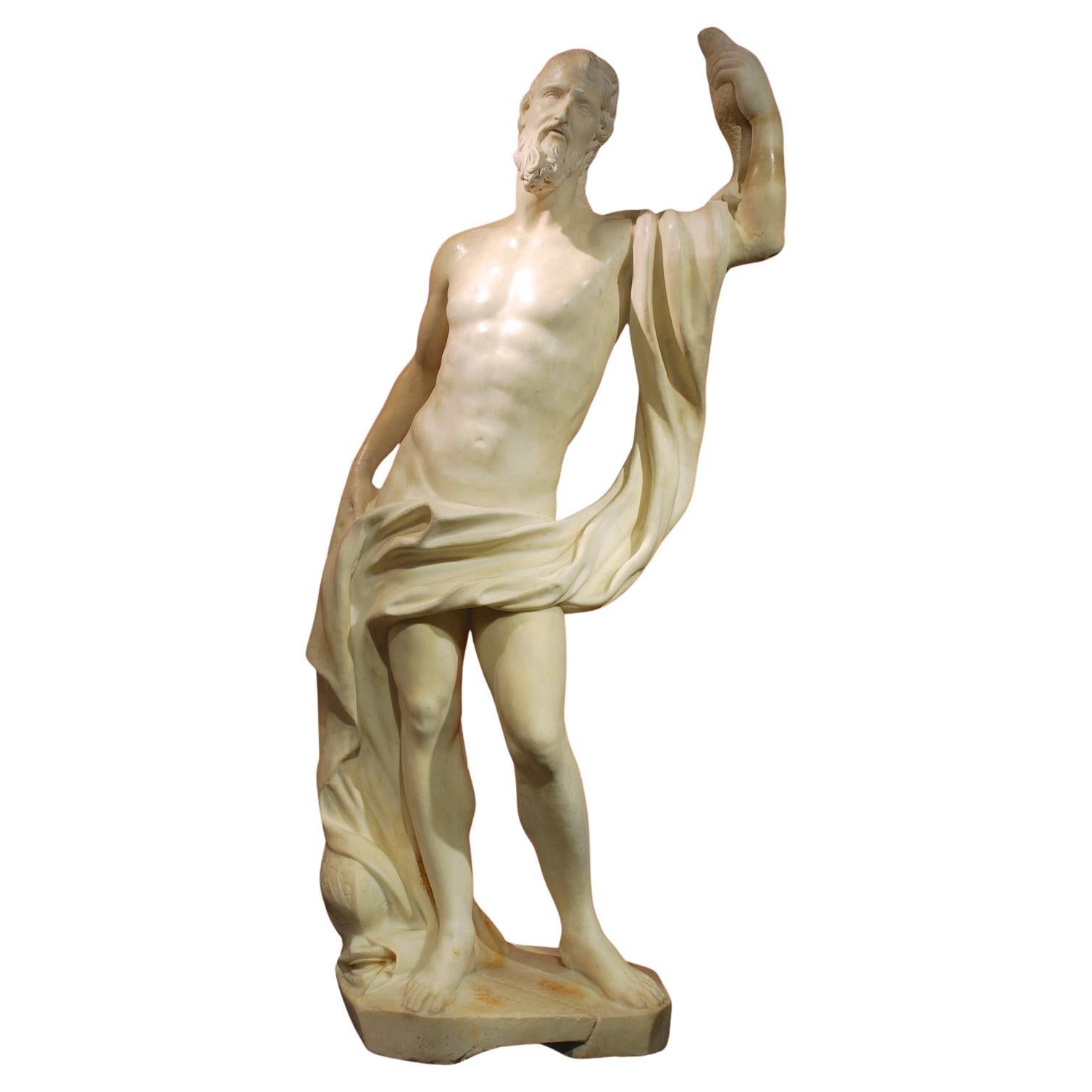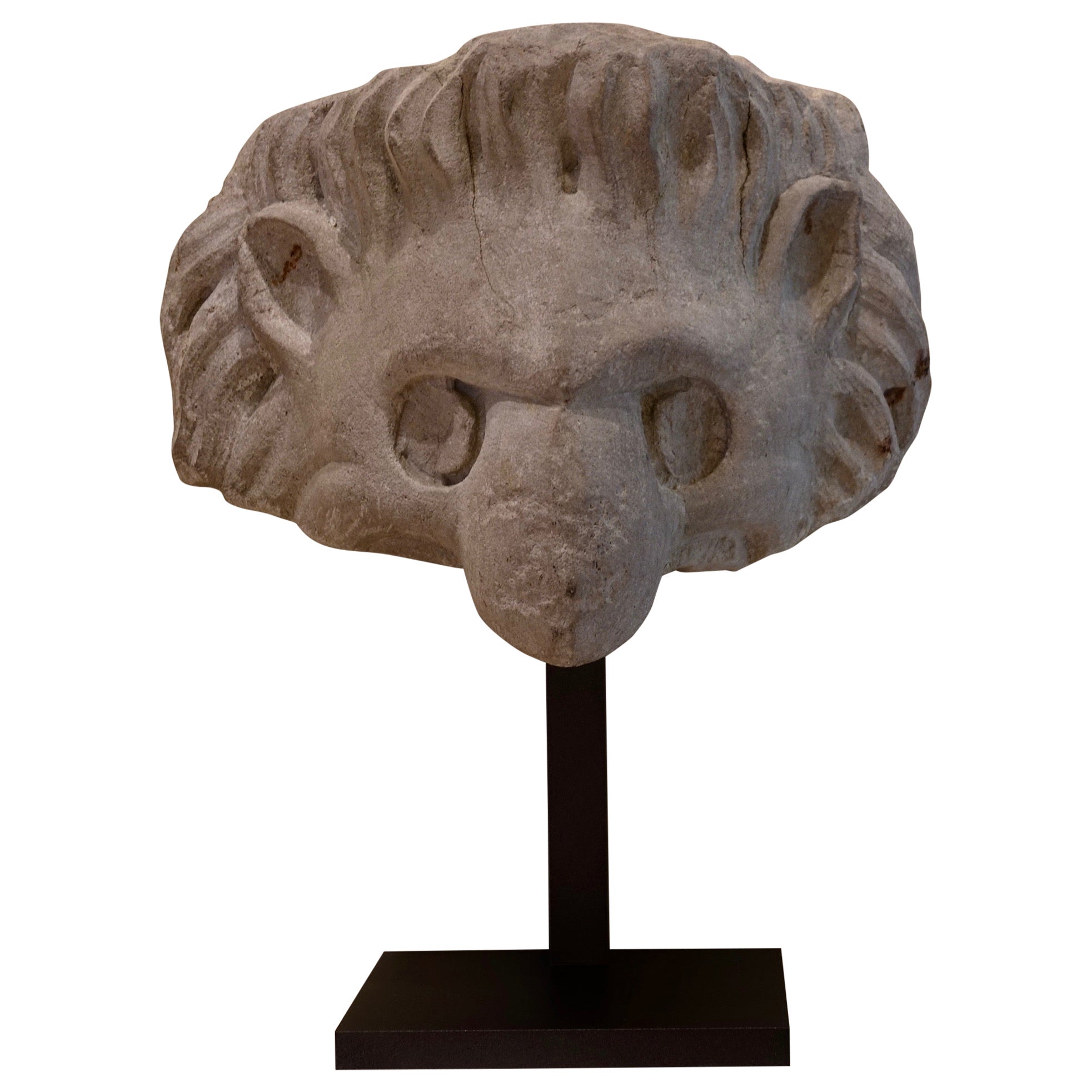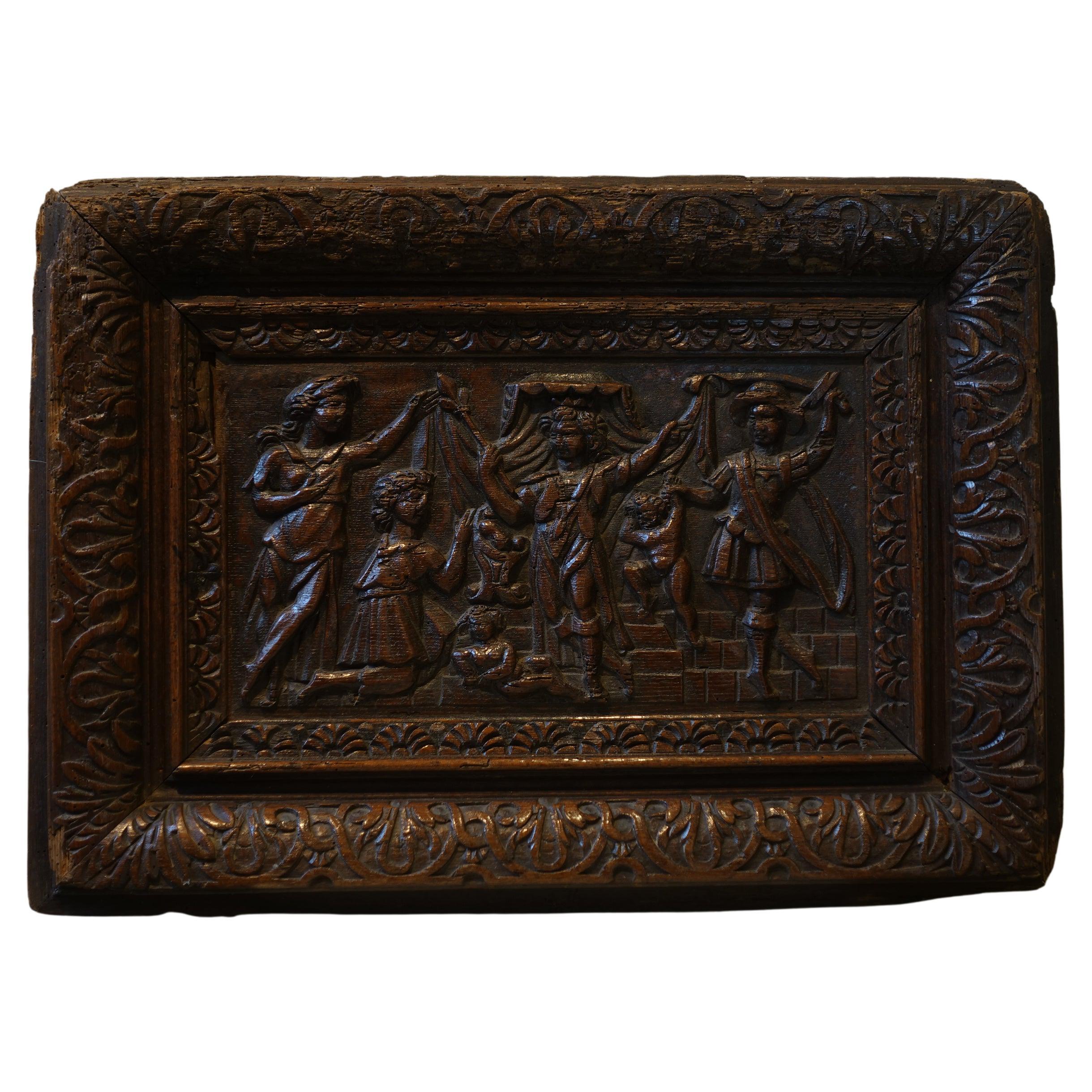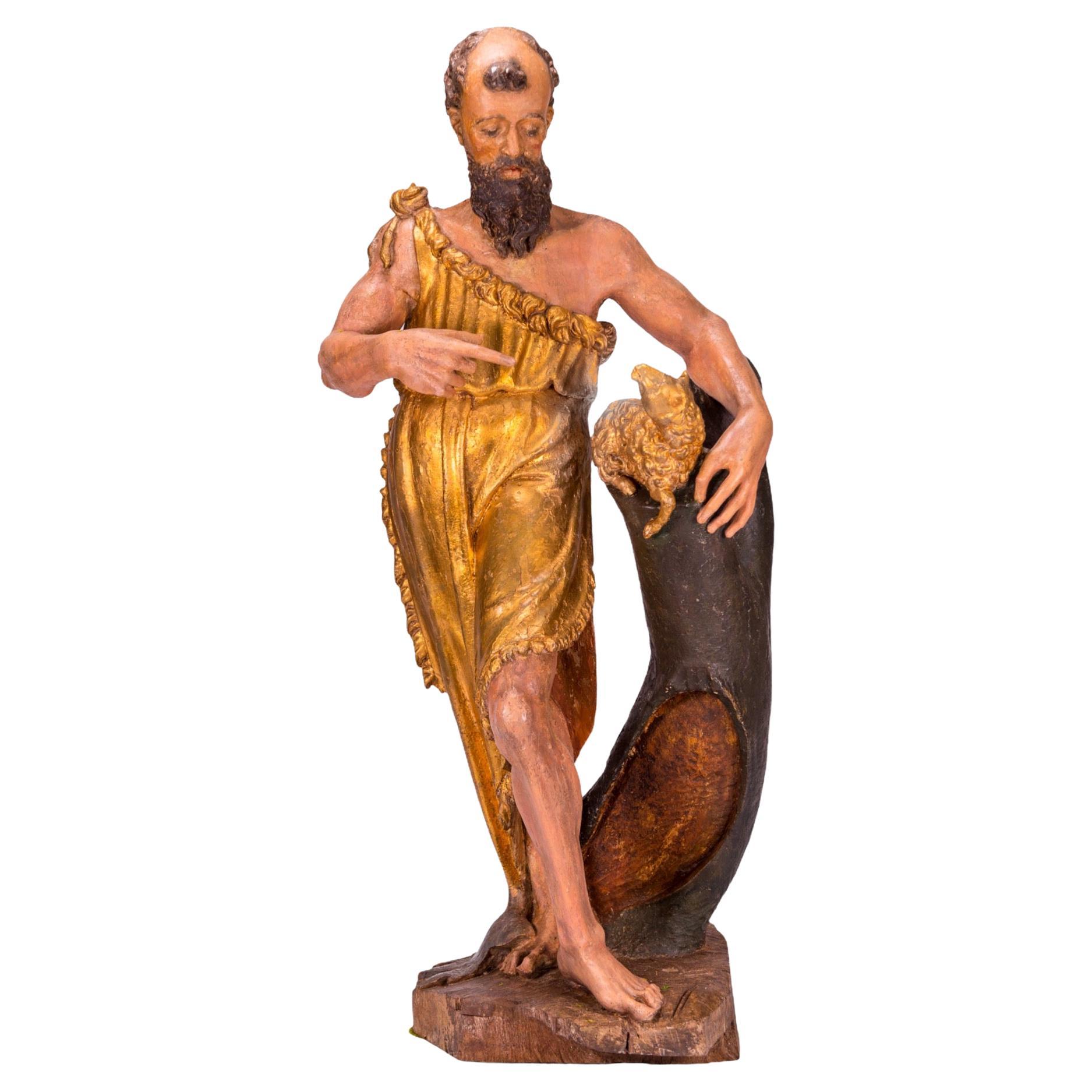Items Similar to Group of Altarpiece - Antwerpen, 16th century
Want more images or videos?
Request additional images or videos from the seller
1 of 6
Group of Altarpiece - Antwerpen, 16th century
About the Item
Group of altarpiece representing the life of a Saint, Saint Renualde?
Engraved by the sign of Antwerp hand on the hat of the central character
Carved oak, traces of polychromy
First half of the 16th century
31.5 x 39 x 6.5 cm
Under the rule of the dukes of Burgundy and the Habsburg, the former Low Countries experienced an exceptional economic boom in the 15th and 16th centuries, fostering a flourishing artistic activity within the major centers of the region. This was notably the case in Mechelen, Antwerp, and Brussels, which specialized in the production of large wooden altarpieces, depicting episodes from the life of Christ and the Virgin.
While Brussels dominated in the 15th century, Antwerp seemed to take precedence in the 16th century. At this time, Antwerp became the main port of Europe and the hub of a trade in which one of the essential components was the market for art and luxury objects. Around 1500, the production of altarpieces became massive, explained by several factors. On one hand, Antwerp sculptors and painters, belonging to the guild of Saint Luke unlike the Brussels artists, could collaborate more easily, as their production was strictly regulated in terms of wood quality and polychromy. On the other hand, Antwerp production was done in series, in advance, to be subsequently placed on the market. This offered greater freedom while allowing for standardization aimed at increasing the number of models produced. Finally, sculptors and painters were often affiliated with entrepreneurs responsible for selling the works wholesale to couriers, who then distributed the works throughout Europe.
The increasing number of altarpieces at the end of the Middle Ages and in the 16th century also reflects the evolution of piety in the former Low Countries, the cradle of the devotio moderna seeking a direct link with the divine. The 16th century, marked by political, social, and religious upheavals, saw in sacred art a crucial means of expressing the Catholic faith. Antwerp, as a bastion of Catholicism, became the center of intense artistic production, with wooden altarpieces being essential elements. In the domestic sphere, the contemplation of religious images facilitated personal meditation and provided access to spiritual experience. Lay or religious sponsors could install modest-sized altarpieces in an oratory or simply in a room, on a sideboard covered with a cloth serving as a private altar. Workshops in Brussels, Mechelen, and Antwerp produced numerous examples of such altarpieces, featuring various styles, compositions, and formats.
Guilds played a central role in this specialized production. They rigorously organized creation, precisely defining each technical element, from the choice of wood to that of pigments, and also determined who was responsible for which task. Each city affixed a certification mark on works created under its auspices, according to the rules it had established. The most famous of these marks is probably the Hand of Antwerp, which appeared around 1470 and is found on both sculpted elements and the very case of the altarpieces. The small hand (Handwerpen, detached hand), stamped in the wood with a red-hot iron, refers to a legend about a giant hand-cutter who terrorized the population before being defeated by the local hero, Brabant. Medieval sculptors from Antwerp were required to become members of the Guild of Saint Luke and had to abide by its regulations. When the jurors found that the requirements were met, an iron punch would imprint a mark in the wood.
The Antwerp origin of our sculpted group is thus confirmed and specified by the presence of a small hand, a "guarantee mark," applied with iron on the head of the central character. All indications agree to date the altarpiece to the first half of the 16th century, around 1530. The work corresponds to a certain peak of Antwerp workshops, combining quality materials, intensive production, and mastery of style. This is characterized by graceful elegance, somewhat affected in the representation of the characters. The simple craftsmanship, angular drapery, and stiff lines combine with the delicacy of expressions and finely featured faces. Our group is not only emblematic of Antwerp production certified by the red iron mark depicting a detached hand but also rare because it presents an unusual scene from the life of a local saint, unlike the dominant themes related to the Passion of Christ and the life of Mary. To the left, a woman with elaborate hair turns her back to the two male figures beside her. One, dressed in an apron, stands in the center, while a third figure, clad in a kind of armor and wearing only one shoe, completes the composition on the right. The men wear wide, short coats to the knees, with split sleeves leaving the forearms exposed. The woman, with a charming face and a high forehead, is wearing a veil with a short visor tied at the back. Her dress is split in front, revealing the underskirt; the neckline is square, and the sleeves are voluminous.
The composition, elaborate costumes, finely sculpted, as well as the variety of attitudes of the characters, are equally remarkable. The theatrical positions betray an influence of the Antwerp Mannerist style, suggesting a dating to the first half of the 16th century, in accordance with the hairstyles and hats of the characters. Concrete details and picturesque costumes reveal a typical taste of Brabantine works, but also of late Gothic art attached to expressive and narrative values.
It is possible that the scene depicted is drawn from the life of Saint Renelde. According to an ancient tradition, when her parents entered religious life, Renelde wished to join her father at the Abbey of Lobbes, which was denied to her. She then went to the Holy Land and, upon her return seven years later, withdrew from the world to settle in Saintes, a village in the Duchy of Brabant, with her two faithful servants, Grimoald and Gondulphe. She devoted herself to charitable works, and according to local tradition, miracles occurred at her tomb. Her body was exhumed in 866 and placed in a shrine, quickly making the site a place of pilgrimage. Saint Renelde is always depicted with her two faithful servants, Grimoald and Gondulphe, who were murdered with her.
The group presented was part of an altarpiece that, like many others, was dismantled during the iconoclastic revolutions, the dissolution of monasteries, and wars.
This meticulously sculpted work, intended for private devotion, describes with great attention to detail the facial features and costume details, such as the intertwining veil covering the head of the female figure, as well as the dress with puffy sleeves and accentuated folds.
Wooden altarpiece groups in Antwerp in the 16th century represent a pinnacle of Flemish sacred art. Their creation was the result of a tumultuous but artistically rich period, where spirituality and creativity intertwined to produce works that transcend time.
Related literature :
M. Buyle and C. Vanthillo, Retables Flamands et Brabançons dans les Monuments Belges, Brussels, 2000
G. Derveaux - Van Ussel, Retables en bois, Bruxelles, 1977, Musée Royaux d’art et histoire. Guide du Visiteur).
Huysmans ed., " La sculpture des Pays-bas méridionaux et de la Principauté de Liège XVe et XVIe siècles ", 1999.
S. Guillot de Suduiraut, Sculptures brabançonnes du musée du Louvre, Bruxelles, Malines, Anvers, XVe-XVIe siècles, Paris, 2001
H. Nieuwdorp (ed.), Antwerpse retabels, 15de-16de eeuw, exhibition catalogue, Museum voor Religieuze Kunst Antwerpen, 1993
P. Williamson, Netherlandish Sculpture: 1450-1550, cat. Victoria and Albert Museum, London, 2002
- Dimensions:Height: 12.41 in (31.5 cm)Width: 15.36 in (39 cm)Depth: 2.56 in (6.5 cm)
- Style:Renaissance (Of the Period)
- Materials and Techniques:
- Place of Origin:
- Period:
- Date of Manufacture:16Th century
- Condition:Wear consistent with age and use.
- Seller Location:Bruxelles, BE
- Reference Number:1stDibs: LU6666238315282
About the Seller
5.0
Vetted Seller
These experienced sellers undergo a comprehensive evaluation by our team of in-house experts.
1stDibs seller since 2022
6 sales on 1stDibs
Typical response time: 7 hours
- ShippingRetrieving quote...Ships From: Bruxelles, Belgium
- Return PolicyA return for this item may be initiated within 3 days of delivery.
More From This SellerView All
- Griffin Head, Italy, 16th CenturyLocated in Bruxelles, BEGriffin head Italy, 16th century On a modern metal stand Measures: 20 x 29 x 21 cm (without the stand) The griffin is a legendary creature with the body of a lion, the head an...Category
Antique 16th Century Italian Renaissance Animal Sculptures
MaterialsMarble
- Massacre of the Innocents, Normandy, Late 16th CenturyLocated in Bruxelles, BEThe Massacre of the Innocents Carved oak panel Normandy, late 16th century (Collection labels on the back) Measures: 43,5 x 61 cm.Category
Antique 16th Century French Renaissance Wall-mounted Sculptures
MaterialsOak
- renaissance wooden candelabrum and painted cross - Umbria, 16th centuryLocated in Bruxelles, BEBase of a carved wooden candelabrum, polychrome and gilded; cross painted on both sides. Umbria or Tuscany, 16th century 136 x 43,5 x 30 cm (The cross and the base of the candelabrum were later assembled) The base of the candelabrum is intricately carved and adorned with polychrome and gilded finishes. The shafts take on the shape of balusters reminiscent of ancient columns, feature ornate foliage decorations, garlands and winged cherub faces. The feet are crafted in the likeness of lion paws. The base is further embellished with depictions of four saint martyrs, among them Saint Barbara and Saint Catherine of Alexandria. The plasticity of the figures, outlined with strong contour lines, the clear and vibrant colors, are stylistic elements linked to the Umbrian tradition of the sixteenth century.The precisely defined and elegant drawing, along with the clear color palette applied with refined chiaroscuro modulations, became the signature of a style that would leave a lasting mark on the era to come. This is exemplified by a preference for vibrant, multicolored images, accentuated in this case by the use of red and pink in the saint's attire. A notable addition, introduced later, is a polylobed cross painted on both sides. On one side, the Crucifixion is vividly portrayed:The treatment of the corpus itself is in line with High Medieval practice, emphasizing pathos by showing Jesus dead, his arms sagging from the weight of the body. The upper section displaying a pelican pecks at her breast to feed her young with her own blood; a symbol of the sacrifice of Christ on the cross whose body and blood similarly nourishes the celebrant during Mass. The lower part depicts Golgotha. On the reverse side, the Resurrection is artistically presented in a Renaissance iconography, reminiscent of the renowned composition painted by Piero della Francesca, now housed in the Civic Museum of Sansepolcro. In terms of composition, with the frontal depiction of Christ holding the banner, this motif became particularly widespread in central Italy, spanning from Tuscany to Umbria throughout the 16th century.. The double-sided construction suggests that it may also have been carried in liturgical processions. In Umbria from the 14th century, the use of portable crosses painted on both sides had become a widespread practice, aimed at satisfying the monastic clientele that had significantly increased following the establishment of new religious communities. The earliest surviving Tuscan painted crucifix represent Christ as Christus Triumphans, or the “Triumphant Christ” with his head up and eyes open. This form was supplanted in the 13th century with the Christus Patiens, or “Suffering Christ” type who is shown often with his head fallen on his shoulder and his eyes closed, as In our cross. The iconography of the suffering Christ appears to have developed out of a new interest in Christ’s human nature, the development of the feast of Corpus Christi and with increased importance given to the Eucharist. The process of humanizing the figure of Christ reaches its peak with the abandonment of all the previous expressive conventions in favor of more realistic details we can observe in this Crucifix, such as the swollen belly, the arms stretched to the limit of muscle tearing, the body falling heavily forward, the abundant blood on the wounds, and the cross firmly embedded in the rock of Calvary. It's worth noting that Renaissance candelabra...Category
Antique 16th Century Italian Renaissance Figurative Sculptures
MaterialsWood, Giltwood
- Bronze Mortar, Tuscany, Second Half of 16th CenturyLocated in Bruxelles, BEBronze mortar with garlands, flowers and putti - Tuscany , second half of 17th century. Measures: height 10 diameter : 13 cm Artisans and healers used mortars for grinding food...Category
Antique 16th Century Italian Renaissance Scientific Instruments
MaterialsBronze
- 16th century Brussels tapestry - The Story of DavidLocated in Bruxelles, BE16th century Brussels tapestry The Story of David Brabant, 16th Century Monogram at the bottom left. 320 x 250 cm This splendid Brussels tapestry, crafted from wool and silk during ...Category
Antique 16th Century Belgian Renaissance Tapestries
MaterialsWool, Silk
- Adoration of the Magi, Flanders, 17th CenturyLocated in Bruxelles, BEThe Adoration of the Magi. Panel carved in high relief. Flanders, 17th century. Measures: 53 x 32,5 cm.Category
Antique 17th Century Dutch Renaissance Figurative Sculptures
MaterialsWood
You May Also Like
- 16th Century Polychrome Reliquary of a MonkLocated in Saint-Ouen, FRThe monk is depicted with an oval face, marked with high and strong cheekbones, sunken cheeks, strong jawbones and a cleft chin. His almond shaped eyes are opened under very strong a...Category
Antique 16th Century Italian Renaissance Busts
MaterialsWood
- A 16th century carved marble sculpture of poseidonLocated in London, GBThis fine and imposing sculpture is an excellent example of 16th century Italian craftsmanship. The figure is stood on a raised, shaped rectangular base with a carved "dolphin" at th...Category
Antique 16th Century Italian Renaissance Figurative Sculptures
MaterialsMarble
- Misericord. Carved wood. 16th century.Located in Madrid, ESChoir Mercy. Carved wood. Century XVI. Carved wooden Misericordia that surely belonged to a choir stall (see the upper flat part, which acts as a seat), decorated with a figurative ...Category
Antique 16th Century European Renaissance Figurative Sculptures
MaterialsOther
- Sculpture of John The Baptist, 16th CenturyLocated in North Miami, FLEarly 16th Century Spanish gold gilded and polychromed carved wood sculpture of John The Baptist.Category
Antique 16th Century Spanish Renaissance Figurative Sculptures
MaterialsGold Leaf
- 16th CENTURY MARBLE SCULPTURE OF A YOUNG HERCULESLocated in Firenze, FISplendid sculpture in white Carrara marble depicting a young Hercules holding the world. Originally, the work was conceived to be used as a caryatid at the beginning of a sumptuous m...Category
Antique 16th Century Italian Renaissance Figurative Sculptures
MaterialsCarrara Marble
- 16th Century Southern Germany Wood Figure of Saint RochLocated in Saint-Ouen, FREasily recognizable with his gesture of showing pest effect on his thigh this pilgrim saint is accompanied by an angel curing him. The quality of the wood is noteworthy. Bibliography Louis Réau, Iconographie de l’Art Chrétien...Category
Antique 16th Century German Renaissance Figurative Sculptures
MaterialsWood
Recently Viewed
View AllMore Ways To Browse
Sell Mens Shoes
Sideboard 1500
Sideboard Wood Oak Massive
French Art Deco Plaster
Vintage Flower Sculpture
Ancient Roman Sculpture Bronze
Crown Head Dressed
Female Sculpture Lamp
Angel Head Carved
Flowers Carrier
Antique French Helmet
Jean Pradier
Nudes Women Art Deco Bronze
Thai Teak Wood Sculpture
Art Deco Painting Plaster
Bas Relief Bronze Medallions
Wood Doorstop
Meissen Triton
